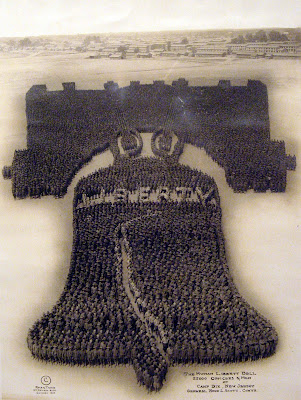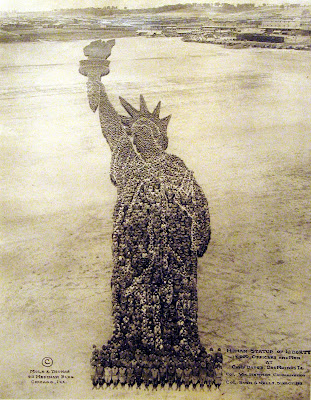Over 90 years ago, Arthur Mole and John Thomas created a series of amazing images to inspire American patriotism. They photographed these enormous ‘Living Photographs’ at military bases throughout the country by carefully positioning up to 30,000 officers, nurses and men to capture the familiar and patriotic subject.
"The Human U.S. Shield, 1918" 30,000 officers and men, Camp Custer, Battle Creek, Michigan
One hundred years ago there was no way that photographs could be ‘pixellated’; yet a pair of inventive snappers managed to achieve something very much like the effect, creating a series of images that would help Americans feel good about themselves and boost patriotism.
The 11th Division Seal
It was in the time just prior to the outbreak of WWI that Arthur Mole and John Thomas came up with the idea of using an eleven by fourteen inch view camera to produce what they called ‘Living Photographs’ on an enormous scale. This involved the careful positioning of many thousands of men in ways that would suggest familiar and patriotic images when photographed from far enough above.
"The Human Liberty Bell, 1918" 25,000 officers and men at Camp Dix, New Jersey
The two ‘pixel pioneers’ decided to construct a wooden tower tall enough that they could take their pictures from as far as 80ft up in the air. Mole often resorted to using a megaphone to position the crowds below. He would mark out the required patterns on the ground by pinning thousands of yards of lace materials to the ground. Each single project called for a great deal of careful planning and preparation - working out correct numbers of men required was not easy.
"The Human Statue of Liberty" 18,000 officers and men at Camp Dodge, Des Moines, Iowa
During his time in pursuit of these endeavours, Arthur Mole visited many military bases, and the servicemen involved were only too happy to help. The secret of getting the images just right lay in finding exactly the right perspective from which to snap them, and Mole was a master at this. Though a ground level view of one of these crowds would have given nothing away, from 80ft up the outlook was completely different.
"Living Emblem of the US Marines" 9,100 officers and men at Paris Island, South Carolina
Mole and Thomas had no desire whatever to profit from their pioneering photography. Though obviously deeply moved by the patriotic fervor they encountered, they felt it appropriate to donate all income from their work to helping government schemes for rebuilding the lives of soldiers returning from active service.
It takes a special kind of vision and talent to pull off these types of pictures, and it seems all the more amazing because of the time in which it all took place. Arthur Mole was an extraordinary talent, and deserves to be remembered.






No comments:
Post a Comment